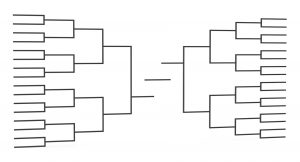How Are Teams Placed in the Tournament Bracket?
The tournament’s bracket revolves around sixteen levels of seeds. The bracket crosses four regions and forms the basis for the simultaneous evaluation of four teams with similar potential. On every seed line, the teams are supposed to be equal.
The selection committee picks four No. 1 seeds from every region. These teams will be playing in the Final Four semifinals. The overall seed number 1 competes with number 4, while 2 competes with 3. Overall, number one can choose the site and region to play in the first and second rounds.
Then, No. 2 seeds from every region are placed in the true seed order. At this point, the principle of keeping teams close to their natural interest may be overlooked. This helps to prevent sending some seeds to the same region as the overall No. 1 seed. However, teams of the same conference are kept in separate regions.
 Again the No. 3 and 4 seeds from each region are placed in the true seed order. Next is reviewing the comparative strength of the regions, which is done by adding the numbers of the true seeds from each region. This procedure helps to check any numerical imbalance. Only five points or less can separate the highest and lowest total.
Again the No. 3 and 4 seeds from each region are placed in the true seed order. Next is reviewing the comparative strength of the regions, which is done by adding the numbers of the true seeds from each region. This procedure helps to check any numerical imbalance. Only five points or less can separate the highest and lowest total.
From the list of true seeds, every team is assigned a bracket group for second-round sites. Seed No. 5 to 16 are placed according to the bracketing principles. The four teams on the seed lines 5 to 16 bear the same numerical value.
Important Considerations
• Rematches between non-conference regular-season games are avoided as much as possible during the first round and the First Four round.
• Upon the examination of the brackets from the last two years, teams and conferences cannot be moved out from their geographical locations for an unreasonable number of times.
• Rematches of the past year’s tournament are avoided in the first and the First Four rounds.








